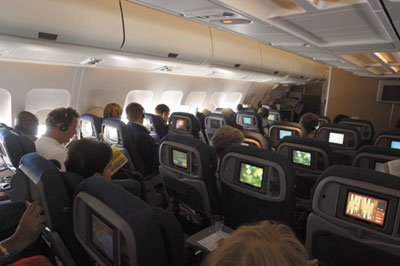Selected flights will offeAccording to official lore at Itasca,
Ill.-based Aircell, the company’s founder first sketched his own
idea for an airplane telephone system on a napkin while sitting in
a Denison, Texas, barbecue restaurant in 1991.
Selected flights will offeAccording to official lore at Itasca, Ill.-based Aircell, the company’s founder first sketched his own idea for an airplane telephone system on a napkin while sitting in a Denison, Texas, barbecue restaurant in 1991.
On Wednesday, Aircell chief executive Jack Blumenstein sat in a terminal at John F. Kennedy International Airport, monitoring several American Airlines flights equipped not with in-flight telephones, but broadband Internet access. The company built the Wi-Fi systems for American, which launched Internet service Wednesday onboard the carrier’s 15 Boeing 767-200 aircraft.
The departure of the San Francisco, Los Angeles and Miami-bound flights from New York marked a key milestone for Aircell, which opened its local facilities less than two years ago to build the technology for Wi-Fi on commercial planes and won an exclusive license from the Federal Communications Commission in 2006.
“This is a very transformative step and in many ways mind-boggling,” Blumenstein said in a phone interview from JFK, where he was preparing to board one of the afternoon flights.
While the skies are slowly opening to Internet connectivity, cell phone usage is still banned by the Federal Communications Commission. Airline executives also say that U.S. customers, unlike many of their European counterparts, want to keep airplanes a cell phone-free zone. Aircell’s Wi-Fi service blocks the use of Voice over Internet Protocol applications.
Market research does indicate demand for Web access, especially on longer flights. A January report by Forrester Research showed that 41 percent of passengers were interested in using the Internet during flights between two and four hours, with that percentage rising to 55 percent when the flight goes over four hours.
Aircell’s in-flight Wi-Fi service is called Gogo and costs $12.95 for flights over three hours. American Airlines has the system installed on just 15 flights for now, all of which fly coast-to-coast routes. Doug Backelin, the carrier’s manager of in-flight communications and technology, said the company will evaluate customer feedback over the next three to six months before deciding whether to expand Gogo across its domestic fleet.
“It’s a turbulent time for the airlines, with oil prices such as they are,” Backelin said. “But we’ve been working on this for years. … Even with the current price of oil, we think it’s going to be a very economically justifiable solution.”
Blumenstein, 65, is a telecom veteran who also co-founded a private equity firm that is one of Aircell’s investors. He joined Aircell’s board of directors in 1997 and became CEO in 2002. The company’s other main business is outfitting private jets with communications systems.
Blumenstein said the Chicago area was a logical choice for Aircell’s more concentrated push into Wi-Fi on commercial aircraft because of the geographical proximity to O’Hare and the talent pool from local companies such as Lucent, U.S. Cellular and Motorola. Aircell has 250 employees in Itasca and another 70 in Denver.
“We kind of felt fortunate in many ways that we came along at the end of the telecom meltdown and were able to get absolutely wonderful, superb talent,” Blumenstein said, adding that he plans to keep Aircell’s commercial aviation business in Itasca.
The Aircell system that turns airplanes into moving Wi-Fi hotspots weighs about 150 pounds, which Backelin said was “not extravagant.” Three antennas on the aircraft search for the best signal from 92 ground-based towers in the continental U.S. Aircell built about 10 of these towers and leases the rest. Meanwhile, back on the plane, passengers can access the wireless network with their laptops, BlackBerrys and personal data assistants.
Blumenstein said Aircell’s capabilities are evolving in tandem with developments in the cellular industry, which is now investing in fourth-generation networks that will allow speedier transmission of heavy data traffic. The next generation of networks is expected to spur growth in multimedia features on mobile phones, with consumers streaming video or playing graphics-intensive games on their handsets. For Gogo users, the advent of 4G networks could mean watching live HDTV in the air, Blumenstein said.
“We are riding that curve and it’s one of the fastest technology curves the world has ever seen,” he said.
Aircell’s air-to-ground Wi-Fi system is lighter than the equipment needed for satellite-based wireless service, an alternative technology that Southwest Airlines and Alaska Airlines are testing. Meanwhile, Delta Air Lines and Virgin America are working with Aircell.
Blumenstein said his company has secured enough funding for Gogo’s planned expansion to other airlines. In July, Aircell locked in a $265 million financing package from a group of major investment banks. In addition to backing from Blumenstein’s private equity firm, Aircell also has equity investment from Ripplewood Holdings, a New York-based firm.
“We’re a private company and there are no plans in the near term to change that,” Blumenstein said. “We’ve attracted a lot of interest in the financial community. But for the moment, we’re very happy operating in stealth mode as a private company.”














